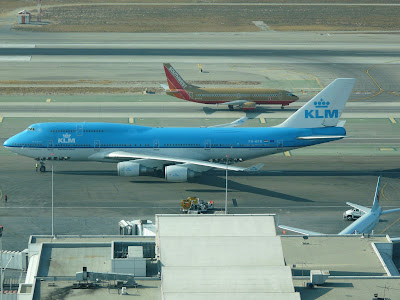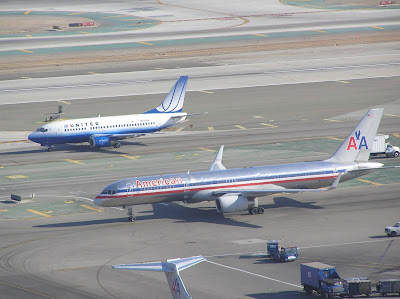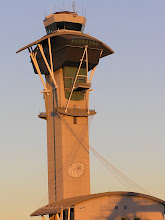B737-300, aka B733


When we're discussing B733s at LAX, we're for the most part talking about Southwest Airlines. Southwest is the predominant operator of -300s at LAX these days, although Continental does show up with one from time to time (2011 update: not any more). Formerly, Frontier and United also had them here (both now have Airbuses instead), as did America West and US Airways. Developed in the early 1980's, the -300 was the first of the second-generation, now referred to as Classic, B737s; the last one was built in 1999. The B733 is nearly ten feet (three meters) longer than the B732 and has a slightly greater wingspan. The most obvious difference, however, is the engines, which are much larger (and more efficient) turbofans. Unlike the original B737s, whose engines were under the wings, the new -300's engines are cantilevered out ahead of the wing. This was done to accommodate the new engine's much larger diameter. Passenger capacity of the B733 is 149 in maximum density configuration, about 20 more than the B732. It used to be that you could tell a Classic B737 from a Next Generation model by the presence or absence of winglets, but no longer. Southwest and Continental have both retrofitted some of their Classic models with winglets; the shots above show one with and one without. In the Next Generation series of the B737, the -300 model has been replaced by the -700 (Continental had and Southwest has both).



 With an Air France B777-200
With an Air France B777-200 With a Shanghai Cargo MD-11
With a Shanghai Cargo MD-11 From the archives: With a (now retired) Alaska MD-80
From the archives: With a (now retired) Alaska MD-80 Also from the archives: Two former America West aircraft, now in US Airways colors: At Gate 8, a B733; while Gate 10 hosts an A319
Also from the archives: Two former America West aircraft, now in US Airways colors: At Gate 8, a B733; while Gate 10 hosts an A319 With a British Airways B744
With a British Airways B744 Another from the archives: A United B733 with an Allegiant MD-80
Another from the archives: A United B733 with an Allegiant MD-80 With a KLM B744 (another archive photo - this aircraft is now blue)
With a KLM B744 (another archive photo - this aircraft is now blue)(And no, I'm not talking about the heavy jet!)
 With a Horizon Dash 8
With a Horizon Dash 8 This is how a B733 looks from a bit further away; in this case going opposite the normal flow of traffic on our new Taxiway Romeo (which we generally use for southbound aircraft) because Taxiway Sierra was closed that day. Seen with an American B738 in the foreground at American maintenance and a Delta A332 in the background on Taxiway AA (that's over a mile from the tower!)
This is how a B733 looks from a bit further away; in this case going opposite the normal flow of traffic on our new Taxiway Romeo (which we generally use for southbound aircraft) because Taxiway Sierra was closed that day. Seen with an American B738 in the foreground at American maintenance and a Delta A332 in the background on Taxiway AA (that's over a mile from the tower!)B737-400 (B734)

Just as Southwest is our primary operator of -300s, Alaska is our main -400 operator. In fact, now that I think of it, Alaska is the only regular B734 operator at LAX. The -400 was developed as a stretched -300, and as such is about 10 feet (3 meters) longer with a maximum seating capacity of 168. Besides the longer length, another spotting clue is the pair of overwing exits on each side of the -400; the -300 only has one overwing exit per side. The -400 model was replaced in the Next Generation series by the -800; Alaska has both.





In the next two shots, a Southwest B733 is shown with an Alaska B734:


The similarity between the -400 and its successor, the -800, is seen in the following two photos. The -800's have a five-foot (1.5 meter) taller tail and winglets:


 With an Alaska B739, which is longer than the B734 and B738
With an Alaska B739, which is longer than the B734 and B738

 From the archives: With a (now retired, thankfully) American Eagle SF34
From the archives: With a (now retired, thankfully) American Eagle SF34 With a Northwest B753 (another archive photo; the B753 now flies in Delta colors)
With a Northwest B753 (another archive photo; the B753 now flies in Delta colors)
The -500 is the smallest of the Classic series models, basically a shortened -300. Almost the same size as the older -200 model, it has a similar seating capacity of 132. United used to have some, and Continental and Southwest still do. Winglets can be retrofitted, and Continental has brought some in that way; I don't think I've seen any Southwest -500s with winglets. In the Next Generation series, the -500 has been replaced with the -600.


 It's crazy, but this seems to be the only photo I've got of a Southwest B737-500 by itself; seen here pushing off of Gate 3 for the first flight of the day (hence the oil smoke from the right engine starting up)
It's crazy, but this seems to be the only photo I've got of a Southwest B737-500 by itself; seen here pushing off of Gate 3 for the first flight of the day (hence the oil smoke from the right engine starting up) A -500 and a -700 together; the -700 on the concrete pad has winglets (and yes, we do call it "the concrete pad" - it's even marked that way on the published airport diagram). Another spotting tip illustrated here: on Southwest aircraft, the stripes on the vertical tail go to the very top tip of the rudder on the -300s and -500s, while they don't make it to the tip of the taller tail on the -700.
A -500 and a -700 together; the -700 on the concrete pad has winglets (and yes, we do call it "the concrete pad" - it's even marked that way on the published airport diagram). Another spotting tip illustrated here: on Southwest aircraft, the stripes on the vertical tail go to the very top tip of the rudder on the -300s and -500s, while they don't make it to the tip of the taller tail on the -700. With the Skywest 35th Anniversary CRJ9, which at LAX flies for Delta;
With the Skywest 35th Anniversary CRJ9, which at LAX flies for Delta;Skywest doesn't use CRJ9s for United at LAX (just CRJ2s and CRJ7s)
 United -500 and an AeroMexico -700 (from the archives; this was taken back when United still had B737s and AeroMexico still parked at Terminal 5). Note the taller tail on AeroMexico
United -500 and an AeroMexico -700 (from the archives; this was taken back when United still had B737s and AeroMexico still parked at Terminal 5). Note the taller tail on AeroMexico This is really an archive photo: Not only does United no longer use B737s, but AeroMexico doesn't have MD-80s anymore, either. This particular one is the shorter MD87
This is really an archive photo: Not only does United no longer use B737s, but AeroMexico doesn't have MD-80s anymore, either. This particular one is the shorter MD87 Another oldie: With a Northwest A320
Another oldie: With a Northwest A320 With an Alaska B738 - again, note the taller tail of the newer model
With an Alaska B738 - again, note the taller tail of the newer model A Continental B735 lifts off from Runway 25 right with an American B763 in the foreground and a Singapore Cargo B744 in the background
A Continental B735 lifts off from Runway 25 right with an American B763 in the foreground and a Singapore Cargo B744 in the backgroundNext time around, we'll look at the Next Generation series. It'll be a little while before I get it done, though - I've gotten all bleary-eyed looking at airplane pictures!






Great shots. In the past, Southwest had the 735 fleet based at Love Field and used to do only "regional" and intra-Texas flights with them. Not sure if thats still the case, but it would help to explain why you have so few shots of them at LAX. I myself have none.
ReplyDeleteThe group shots really emphasize for me the classic, normal airliner conformation of the 737s compared to some of the rather exaggerated stretch models. Great pictures!
ReplyDeleteN